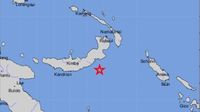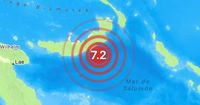A magnitude 6.9 earthquake struck off the coast of New Britain Island, Papua New Guinea, on Saturday morning, April 5, 2025, at 06:04 local time, according to the United States Geological Survey (USGS). The earthquake occurred at a shallow depth of 10 kilometers, with its epicenter located approximately 194 kilometers southeast of the nearest city, Kimbe.
Following the quake, immediate tsunami alerts were issued, warning of potential waves between 1 to 3 meters high along the coast of Papua New Guinea. Smaller waves of about 0.3 meters were also forecast for parts of the neighboring Solomon Islands. However, these tsunami alerts were eventually lifted as the situation stabilized.
Marolyn Simbiken, a receptionist at the Liamo Reef Resort in Kimbe, reported that the earthquake was felt, but there were no significant damages or evacuations. "Yes, we felt the earthquake here... but there has been no major damage. Nothing was damaged here and there was no evacuation," she told AFP.
Just 30 minutes after the initial quake, another earthquake of preliminary magnitude 5.3 occurred near the same location, as reported by the USGS. The aftershocks, which ranged in magnitude from 4.9 to 5.3, are a common occurrence in Papua New Guinea, a region known for its seismic activity due to its position along the Pacific Ring of Fire.
The recent quake is part of a series of tremors that have affected the region. Earlier on the same day, a magnitude 7.1 earthquake was reported by the European-Mediterranean Seismological Center (EMSC) at a depth of 49 kilometers, which also prompted tsunami warnings. This quake was initially valued at a magnitude of 7.1 but was later adjusted to 6.9 by the USGS.
Seismologists note that earthquakes are frequent in Papua New Guinea, which is situated in an area of intense seismic activity affecting Southeast Asia and the Pacific Ocean. The region's tectonic movements are responsible for the numerous earthquakes that occur, making it one of the most active seismic zones in the world.
Despite the frightening nature of these seismic events, experts emphasize the importance of preparedness and awareness in communities prone to earthquakes. Local authorities have been working on improving building codes and emergency response plans to mitigate the impacts of such natural disasters.
While the immediate aftermath of the 6.9 magnitude earthquake did not result in significant damage or casualties, the potential for future quakes remains a concern for residents and authorities alike. The USGS continues to monitor seismic activity in the region, providing updates and alerts as necessary.
In light of these recent events, it is critical for residents in earthquake-prone areas to stay informed about safety protocols and to have emergency plans in place. The experience of the recent earthquakes serves as a reminder of the unpredictable nature of seismic activity and the necessity of being prepared.
As the region recovers from these tremors, officials and residents alike are hopeful that the seismic activity will stabilize. However, the history of earthquakes in Papua New Guinea suggests that vigilance and readiness are essential for ensuring safety in the face of natural disasters.









